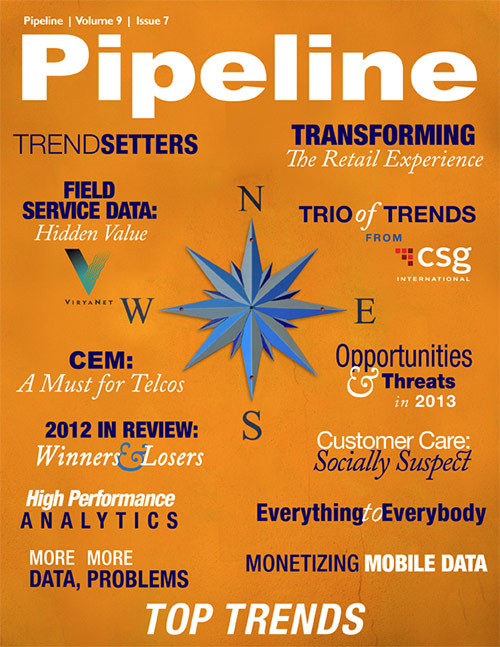Communications IT News
Wireless landscape in flux
The wireless market just ain’t what it used to be. These days it changes in the blink of an eye. Take 4G LTE, for example, the premium wireless network that was once available solely from tier-1, postpaid providers. This month it was announced that consumers can get 4G LTE service from Cricket, as well as the latest iPhone, for a fraction of the cost offered by top-tier providers and without a contract.
Next, take a look at 2012’s buzz-worthy darling, customer experience management (CEM). From the customer’s perspective, AT&T has the best-quality LTE network in the US, but that wasn’t enough to prevent Big Blue from ranking poorly in Consumer Reports’s latest survey. Verizon came out on top overall, but prepaid carriers posted some surprising results. In fact, prepaid carriers performed better than AT&T on some metrics. It’s no surprise that Doug Hutcheson, CEO of Leap Wireless (Cricket), called out customer experience as a driver for his company’s move to 4G LTE. “We’re always looking for new opportunities to provide an enhanced customer experience, and our investment in 4G technology is another way we’re accomplishing that.”
It’s also likely that the service-provider landscape will look dramatically different by this time next year. SoftBank is pitching for Sprint, MetroPCS and T-Mobile want to combine forces, and Sprint will probably make a counteroffer for MetroPCS. Sprint also bought nearly a half billion dollars’ worth of U.S. Cellular’s business, and Clearwire, the wholesale carrier that many had left for dead, is experiencing a spike in share prices as new deals reignite investor confidence.
Mobile virtual network operators (MVNOs) will soon be able to offer the kind of service bundles that are only found in multiple system operators’ (MSOs) catalogs. Sprint announced a new device for MVNOs that enables them to capture and retain landline customers. The device, unlike a traditional VoIP solution, doesn’t require copper, fiber or twisted-pair cabling, and has battery backup for use during power outages.
In the meantime, DISH Network is preparing to enter the wireless market by leveraging its spectrum for an LTE network. In fact, the satellite service provider plans on spending billions to get the network up and running. It faces a three-letter problem, though: the FCC.
While it essentially approves DISH Network’s entry into the market, the FCC wants to lower the proposed network’s power levels by around 25 percent. This does not sit well with DISH.
“While the FCC’s proposed order, based on reported accounts, does properly address some of the opportunities with this spectrum, it’s significantly flawed by introducing serious limitations that impair its utility,” said R. Stanton Dodge, DISH executive vice president and general counsel, in a statement. “While the FCC would grant full terrestrial rights, its proposal to lower our power and emissions levels could cripple our ability to enter the business.”
The regulatory order is not yet finalized, and DISH claims that if it receives the FCC’s blessing it is prepared, according to a November press release, to “invest billions [and] trigger tens of thousands of jobs.” (To read the press release in its entirety, click here.)
Diving into the Microsoft ecosystem
With each passing month, Microsoft looks more and more like the service provider of the future. In the past many CSPs would have considered a partnership with Microsoft akin to a deal with the devil, but the strength of Microsoft’s ecosystem is a compelling reason to play ball.
This month Verizon further expanded its relationship with Microsoft with a Lync-based unified communication-and-collaboration solution that will benefit from collaborative sales and marketing efforts. By becoming a larger component in the vibrant Microsoft ecosystem, Verizon gets a stab at providing and managing the pipes for an increasingly larger services opportunity.
In Russia service provider MTS expanded its relationship with Microsoft to drive mobile internet usage, but the biggest news came from Telefónica in the form of a global video-delivery platform. Microsoft and Telefónica signed a multi-year strategic agreement to create a new Global Video Platform (GVP) for all video entertainment services across Telefónica’s Operating Businesses. The platform is based on key Microsoft technologies, including the Microsoft Mediaroom platform.
“This new platform allows us to reflect the deep and rapid changes happening in this market. It offers the ease and convenience of a global, convergent platform while maintaining flexibility over content for our local businesses. Most important, it allows us to meet customer demands for access to video content on an ever-expanding range of devices,” said Vivek Dev, director of Digital Services at Telefónica Digital.



















